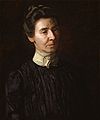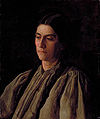
Portrait of Mary Adeline Williams
Encyclopedia

Thomas Eakins
Thomas Cowperthwait Eakins was an American realist painter, photographer, sculptor, and fine arts educator...
, each depicting Mary Adeline Williams (1853-1941), known familiarly to the Eakins family as "Addie". The first painting, now in the Art Institute of Chicago
Art Institute of Chicago
The School of the Art Institute of Chicago is one of America's largest accredited independent schools of art and design, located in the Loop in Chicago, Illinois. It is associated with the museum of the same name, and "The Art Institute of Chicago" or "Chicago Art Institute" often refers to either...
, was completed in 1899, and portrays the subject with a serious demeanor. The second portrait, in the Philadelphia Museum of Art
Philadelphia Museum of Art
The Philadelphia Museum of Art is among the largest art museums in the United States. It is located at the west end of the Benjamin Franklin Parkway in Philadelphia's Fairmount Park. The Museum was established in 1876 in conjunction with the Centennial Exposition of the same year...
, was painted in 1900, and is more emotionally expressive. The contrast between the paintings has been called "Perhaps the most famous example of Eakins's transforming a sitter dramatically while maintaining the effect of severe realism."
Background
Mary Adeline Williams was a longtime friend of the Eakins family, a best friend to Eakins' younger sister Margaret, and a distant relation through marriage; she would later say that Thomas Eakins "was like a big brother to me." As early as 1867 Eakins took a protective interest in her, writing to his sister Fanny: "She is a pretty little girl & I guess just as good as she is pretty, or she belies her blood. We owe a great deal to her father & mother for their unvarying disinterested kindness to us....Try to make her welcome whenever she comes to town."Williams never married, and for some years worked as a seamstress and made corsets. In 1882 Thomas Eakins' father Benjamin invited her to live in the Eakins' home in Philadelphia; Williams demurred, and moved to Chicago, where she lived for six years with one of her brothers. During this time she and Eakins maintained a written correspondence, and the friendship with Eakins' family was further renewed when she returned to Philadelphia in the late 1890s.
Eakins's relationship with Mary Adeline Williams has been the subject of a decades-long debate among art historians. Eakins biographer Lloyd Goodrich
Lloyd Goodrich
Lloyd Goodrich was an influential American art historian. He wrote extensively on American artists, including Edward Hopper, Thomas Eakins, Winslow Homer, Raphael Soyer and Reginald Marsh...
conducted interviews with many of Eakins's surviving friends and family members about a decade after Eakins's death. Goodrich himself thought a sexual relationship was unlikely, believing that Eakins would not be inclined to participate in an extramarital affair in his own home. However, he found that many of Eakins's friends believed that his relationship with Williams was sexual in nature. Eakins' student and confidante Samuel Murray
Samuel Murray
Samuel Aloysius Murray was an American sculptor, and protégé of the painter Thomas Eakins.-Murray and Eakins:...
stated publicly that he believed the relationship between artist and sitter was sexual, and one of Eakins' nephews believed that Eakins, his wife, and Addie were engaged in a ménage à trois. Other Eakins acquaintances, such as as Lucy W. Langdon Wilson, disagreed, noting that Eakins was not interested in seduction, and if a sexual situation developed, she believed "he would leave before the critical moment." It is possible that the portraits reflect Eakins's responsiveness to Williams' varied emotional conditions, rather than recording the effects of a physical relationship.
Composition
The 1899 portrait of Williams depicts her wearing a pleatedPleat
A pleat is a type of fold formed by doubling fabric back upon itself and securing it in place. It is commonly used in clothing and upholstery to gather a wide piece of fabric to a narrower circumference....
black dress with a high white collar. Her hair is in a tight bun
Bun (hairstyle)
A bun is a type of hairstyle, typically worn by women, where the hair is pulled back from the face, twisted or plaited, and wrapped in a circular coil around itself, typically on the back of the head or neck. They can either be secured with a hairpiece, a hairnet and bobby pins. They may be...
, set against a dark brown background. Williams is turned slightly to the right, with a strong light cast on that side of her body. Her lips are pursed and her brow is furled; her expression is nearly a scowl
Scowl
Scowl may refer to:* Scowl, another word for frown* To wrinkle or contract the brow as an expression of anger or disapproval.* Scowl, one of the Monster Pretenders, a subgroup of the Transformers...
. Dark circles are visible under her eyes.
The 1900 portrait depicts Williams from the left side. She is wearing a black dress with red stripes, a pair of red ribbon bowties, and a red ribbon around her neck. Williams's hair is worn down, set against a dark brown background. Her cheek is slightly sunken. Her expression is much softer, virtually inscrutable. The portrait was originally painted on a 24 x 20 inch canvas. Eakins cut two inches off the right side, and tacked it to a new stretcher. This had the effect of re-centering the work on Williams's face.
Composition history
Eakins began the first painting of Addie Williams in late February of 1899; his wife Susan Macdowell EakinsSusan Macdowell Eakins
Susan Hannah Macdowell Eakins was an American artist and wife of Thomas Eakins. She was the fifth of eight children of a Philadelphia engraver, well known in the artistic community...
recorded in her diary that work had commenced on February 26. In it Addie is seen in three-quarters profile in a dark blouse, described as "prison-bar black", with a light scarf around her neck, its bow tied at the front of her throat. Her hair is tightly tied back, and she sits erect and anxious. The portrait is unflinching in its verisimilitude to the lines of the sitter's face and her subtle frown, and has been seen as representative of "spinsterhood" for its characterization of a fastidious and prim personality. Later Susan Eakins recalled that Addie had been "rather worried" at the time. Eakins continued to work on the painting at least through mid-May of that year. The painting entered the collection of the Art Institute of Chicago in 1939.
_1900.jpg)
Lloyd Goodrich
Lloyd Goodrich was an influential American art historian. He wrote extensively on American artists, including Edward Hopper, Thomas Eakins, Winslow Homer, Raphael Soyer and Reginald Marsh...
visited Susan Eakins and Addie Williams in the 1930s, he found "the two elderly women (Addie was two years younger) seemed like sisters, ready with memories and facts about Tom." Eventually Addie Williams inherited one quarter of Eakins' estate.
The second portrait was painted in 1900, during Williams' first year living in the Eakins home. A pendant to the first portrait, the second painting has been called "a romantic fantasia, or unrestricted variation and development on the original theme"; it is more richly and loosely painted than its predecessor. In this version Addie Williams is turned fully toward the light, appears less troubled, with more richly colored skin and mouth. Her lips are fuller, eyes moister, and her hair less constrained and more natural in appearance. The characterization is more intimate, with the angle of the head implying the sense of resignation that Eakins favored in his later portraits. To Goodrich, she appears to be "a kindly woman, wise, gentle, and warm, with a sense of humor— as I found her to be." Her striped dress is adorned with bows and flounces which hide the body beneath vigorous strokes of red-orange paint; the handling of multi-colored drapery has been compared to virtuoso passages by Eakins' American Impressionist contemporaries. The Philadelphia Museum of Art received the painting as a gift from Susan Macdowell Eakins and Addie Williams in 1929.
Interpretation
The difference in mood between the paintings has been ascribed to the possibility of an affair between Eakins and Williams. Eakins' biographer William Innes HomerWilliam Innes Homer
William Innes Homer is an American academic, art historian, and author. Homer is an expert in the life and works of painter Thomas Eakins.-Academic career:...
contrasted the second portrait, "radiantly affectionate", with a contemporaneous painting the artist made of his wife, in which Susan Eakins appears "worn and strained."

Regarding the warmth of the second portrait, Eakins biographer Elizabeth Johns described Addie as she "tilts her head and smiles gently to imply that all will be, really, all right."
Yet another interpretation questions the assumptions that the portraits reflect Addie Williams' fulfillment through sexual or familial ties, or that they record her changes of mood; rather, the difference in the portraits may document Eakins' more profound perception of Williams as he came to know her better. Eschewing a strictly biographical reading, it is possible that the paintings may also allude to broader cultural assumptions about unmarried women, and to Eakins' interest in visiting variations on a theme.
Referring to Eakins' achievement in the second portrait, Homer wrote: "It is one of the first portraits in which he opened himself up to a particular woman rather than visualizing her according to his earlier intellectualized notion of a woman cast in a masculine mold. The painting marks the beginning of Eakins's ability to empathize with women in portraiture." Goodrich called it "one of his most sympathetic, intimate portraits of a middle-aged woman."
Based on a perceived resemblance, several of Eakins' biographers have speculated that Addie Williams later served as a model for the artist's 1908 nude studies for William Rush and His Model
William Rush and His Model
William Rush and His Model is the name given to several paintings by Thomas Eakins, one set from 1876-77 and the other from 1908. These works depict the American wood sculptor William Rush in 1808, carving his statue Water Nymph and Bittern for a fountain at Philadelphia's first waterworks...
. Goodrich, describing the model for the nudes as " a mature woman" and a distinctive individual, did not see a resemblance to any of Eakins' portraits, and believed her to have been a professional model.

